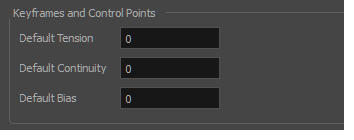When you animate a camera movement with more than two keyframes, the path of the camera follows a curve that touches every keyframe in its animation. Using the Keyframes and Control Point toolbar, you can adjust how the path curves before and after each keyframe in the camera's trajectory.
When a camera keyframe is selected, the Keyframes and Control Point toolbar gives you access to three settings that can be applied to that keyframe. Each setting can have a value ranging from -1 to 1. When all fields are set to their default value, 0, the curve is constant and even. Here is an example opf how each setting can affect the camera path:
- T (Tension): A positive tension will reduce the curve of the path between keyframes. A negative tension will increase it.

- C (Continuity): A positive continuity will cause the path to curve beyond the trajectory between each keyframes. A negative continuity will have a reverse effect.

- B (Bias): A high bias will make the curve more straight before the keyframe and more curved out after it. A negative bias will make the curve more curved out before the keyframe and more straight after it.

- Add the Keyframes and Control Points toolbar to your workspace by doing one of the following:
- In the top menu, select Windows > Toolbars > Keyframes and Control Points.
- Right-click on a toolbar or on the empty space around a toolbar and select Keyframes and Control Points.
The Keyframes and Control Points toolbar appears

- In the Tools toolbar, select the Camera
 tool.
tool.
- In the Timeline view, select the keyframe or control point you want to adjust.
- In the Keyframes and Control Points toolbar, enter values between -1 and 1 in the Continuity, Tension, and Bias fields until the path before and after the selected keyframe is the way you want it to be.
- Select Edit > Preferences (Windows) or Storyboard Pro > Preferences (macOS).
The Preferences dialog box opens.
- Select the Camera tab.
- In the Keyframes and Controls Points section, enter the defaults for Tension, Continuity and Bias, based on your preferred settings.
